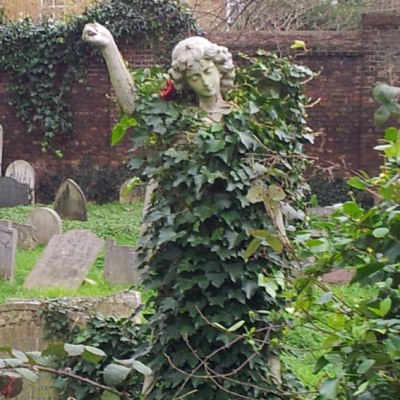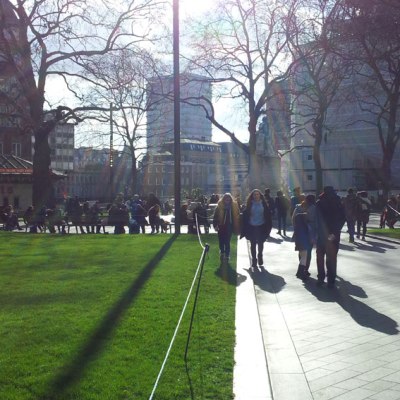(Thursday 25 February 2016)
It’s not in the strictest sense a park or garden, but Brompton Cemetery is administered by Royal Parks and is designated Grade 1 on the English Heritage Register of Parks and Gardens. An oblong of 39 acres, it stretches out south of Earls Court for half a mile and kicks against Stamford Bridge (Chelsea FC football ground) in the south. It contains over 200,000 resting places, a verdant treasury of 35,000 memorials, dating from the early 1840s.
This land was originally market gardens on land owned by Lord Kensington. It was purchased as part of a scheme to establish a ring of suburban cemeteries (known as the ‘Magnificent Seven‘). These were intended to relieve the huge pressure on London’s burial grounds at a time when the population was soaring and most city churchyards were only intended to serve village- sized populations. Other cemeteries established at this time include Kensal Green and Highgate.
 The formal layout was based on the plan of a cathedral, with a wide central ‘aisle’, long and impressive, leading past colonnades and bell tower towards an octagonal domed chapel. Parallel side aisles and transverse paths form a grid pattern out towards the high brick walls which contain the whole site.
The formal layout was based on the plan of a cathedral, with a wide central ‘aisle’, long and impressive, leading past colonnades and bell tower towards an octagonal domed chapel. Parallel side aisles and transverse paths form a grid pattern out towards the high brick walls which contain the whole site.
Famous occupants chart the social, political, commercial and artistic history of the past two centuries, including broadcaster Bernard Levin, Edward Wadsworth the Vorticist painter, the cricketer, John Wisden and Samuel Cunard, founder of the shipping line. But possibly the most influential resident is Emmeline Pankhurst, leader of the suffragettes. As I walk from the entrance gates and set off along the main central avenue, her grave and tall sandstone Celtic cross are just there on the left. It is well cared for with pots of tulips in bloom and a vase of irises freshly placed.
 The central avenue stretches to the south, boulevard- wide. On this sunny morning, shadows cast from the procession of lime trees curl and criss- cross the tarmac. Distant cyclists and runners are tiny smudges which gradually enlarge, then whoosh by. I wander past elaborate but shabby mausoleums, age- stained angels, standing high. Gravestones range from the polished and sharp, to the cracked and lichen- blotched, their inscriptions long eroded.
The central avenue stretches to the south, boulevard- wide. On this sunny morning, shadows cast from the procession of lime trees curl and criss- cross the tarmac. Distant cyclists and runners are tiny smudges which gradually enlarge, then whoosh by. I wander past elaborate but shabby mausoleums, age- stained angels, standing high. Gravestones range from the polished and sharp, to the cracked and lichen- blotched, their inscriptions long eroded.
I walk a path towards a gleaming Paperbark birch over to the right, its branches reaching bone- white into the sky. I get my sketchbook out and try to draw how it frames the colonnade of arches and bell tower. The arches are echoed by the assorted grave tops, filling the space in front of me, probably as varied in shape, size, colour and texture as the individuals that they commemorate. Amongst them, grasses, weeds, dog rose stems and evergreen bushes of holly, laurel and boxwood thrive. The occasional dark form could be a figure standing in contemplation, or just a side- view gravestone, upright in the shade of a tree. Sun passes, then steely clouds, then sun again. The breeze is a cold breath on the back of my neck. One or two people pass by. We nod hellos. Some walkers approach from way up the long straight path but, at the next glance, they just seem to have just faded away.
There’s more life here than in any of the parks and gardens I’ve visited so far. Squirrels scratch and leap, a robin choruses from an ash branch right overhead then hops close by from stone to stone. Crows caw. A rural serenity broken only by clangs and girder dongs from nearby construction sites. Trains rattle and scree into West Brompton station just over the west wall. I hear a jogger with a squeaky trainer advancing from far off; he lopes past, then squeaks away towards the south end.
Drawing completed, I walk back to the central drive, then down between the colonnades, through a forest of wonky stone crosses. I pause to watch a fashion shoot happening against the mottled stone, then skirt round the chapel, and beyond into the southern end.
 I find another view to draw: looking back to the chapel rising through the wilderness; honey Bath stone gleaming in the sunlight. Here the cemetery is wilder, dishevelled and unkempt, brambles well- established. Ivy wraps around rust-railed tombs, rambling holly and yew have taken over. Nettles push through the complexity of bleached stems from last year’s jungle. An old, grey- muzzled fox warms himself against a stone sun-trap, hardly bothered by my presence. A younger, brighter red fox dashes across the path into the unconsecrated burial ground behind, pursued by a yipping spaniel, which ignores its owner’s calls, as she waves her poop- scoop.
I find another view to draw: looking back to the chapel rising through the wilderness; honey Bath stone gleaming in the sunlight. Here the cemetery is wilder, dishevelled and unkempt, brambles well- established. Ivy wraps around rust-railed tombs, rambling holly and yew have taken over. Nettles push through the complexity of bleached stems from last year’s jungle. An old, grey- muzzled fox warms himself against a stone sun-trap, hardly bothered by my presence. A younger, brighter red fox dashes across the path into the unconsecrated burial ground behind, pursued by a yipping spaniel, which ignores its owner’s calls, as she waves her poop- scoop.
I finish and, as I pack up my sketchbook and drawing things, I peer over at the inscription on the stone right in front of me, draped with hanging bramble tendrils. It reads: ‘FRANCIS NICHOLSON 1753 – 1844 LANDSCAPE PAINTER’. How amazing and coincidental! Of all the places I could have chosen! I’ve been drawing and painting in this spot for over an hour, unknowingly paying homage to one of the greatest pioneers of landscape watercolour painting! He is kept company here by his artist daughter, Marianne Croker and her husband Thomas Crofton Croker, who was an antiquary. I’ve always loved the series of strong pastoral paintings that Francis Nicholson made at Stourhead in the early years of the nineteenth century. I regularly used them to inspire my students in the painting workshops I taught at Stourhead each summer.
I brush the stone free of vegetation and gently sprinkle my painting water onto his overgrown grave.
In his ‘Sticks in the Smoke’ project, Nick Andrew has been regularly visiting, researching and drawing different publicly accessible parks or gardens in London since January 2016, exploring the theme of city green spaces from the perspective of a rural landscape painter. The first two sketchbooks will be published as a book in late 2018. www.nickandrew.co.uk . Nick is grateful to London Parks & Gardens Trust for their support www.londongardenstrust.org.
Brompton Cemetery, Fulham Rd, London SW10 9UG
Google earth view here


















